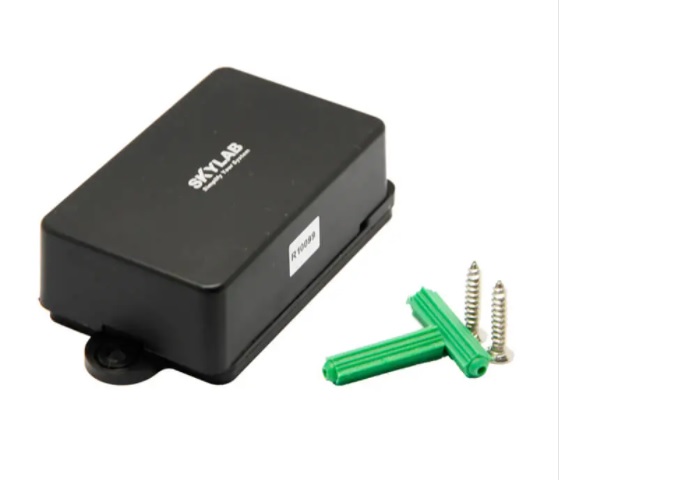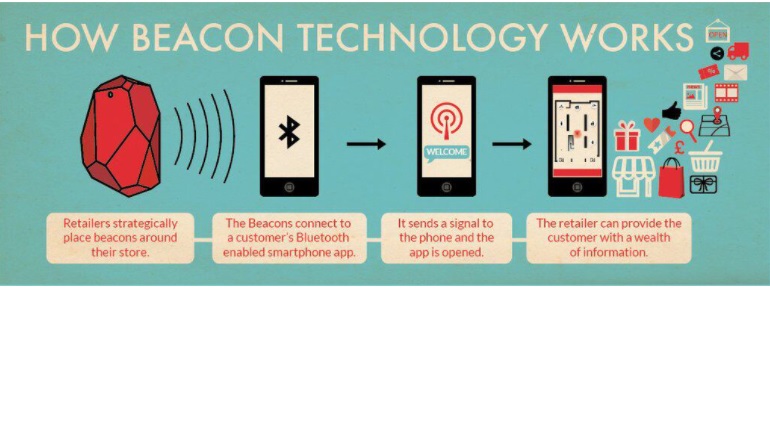As GPS technology brought a revolution in outdoor positioning, Bluetooth Low Energy or BLE beacon technology revolutionized the indoor positioning technology. Therefore, BLE is a type of wireless communication designed specifically for short-range communication. Also, the technology is pretty much the same as Wi-Fi in a way that it expedites devices' communication with each other. BLE serves its purpose well when users prefer battery life over high data transfer speeds. For example, a company may send its customers timely and important messages about nearby products through beacon marketing. Since the data required to transfer to a customer’s smartphone is minimal, BLE-compatible beacons do the job quickly. There is no risk of draining the battery.
Since satellite-based positioning tends to fail in indoor positioning, therefore, modern tablets and smartphones used today are BLE compatible. Bluetooth is a wireless technology standard meant for exchanging data over short distances. This means that BLE-compatible beacons can flawlessly communicate with Bluetooth-enabled devices indoors.

In addition, these devices are usually wireless headphones, smartwatches, beacons, digital signage, fitness trackers, or car stereos, etc. BLE device is composed of two parts: a broadcaster (beacon) and a receiver (app + smartphone). The beacon broadcasts tiny pieces of data within a short distance and the app detects the signal.
It determines the rough distance to the beacon and acts on the particular location. Thus location-based searching and communication get more precise and easier.
The concept of beacon suggests a new perspective of the old concept of the lighthouse which helps ships navigating in the seas. Apple first introduced this technology along with an unwavering communication standard called iBeacon. Google’s Eddystone was the next to chip in.
In a short time, beacon technology was straightforwardly effective unlike contemporary technologies like Virtual Reality and Augmented. The BLE compatible beacon technology provided stimulating ways to companies who wished to involve customers in a non-intrusive manner.
The beacon itself is a simple device comprising batteries, radio, and a CPU. The device repeatedly broadcasts a signal and a smartphone catches the signal to mark out an important place. On connection, the beacon performs predefined tasks by sending 1 – 20 buckets of small data at 20% of the speed on average.
There are three important elements that make the beacon-based structure work. Also, when a user crosses an area where a beacon positioning system is set up, the nearest beacon sends a code or signal like UUID.
Thus, it means there should be at least one more beacon device that does the job of transmitting a code. That code accompanies the message to the recipient's mobile device. Moreover, the message prompts a notification on the recipient's mobile device with a third-party app – the second element. The third element is the user’s permission whether to receive beacon-based intimations and use the positioning system.
Also, one thing noticeable is that BLE based beacon protocol works only with a smartphone and mobile app. As a result, the users have the option to turn off the Bluetooth. In addition, companies offering BLE-based beacons suggest users turn on Bluetooth by highlighting the advantage of the beacon-based positioning system.
They also term it as an innovative solution to get feedback of full customer experience. Since the user has the choice to opt-out, BLE-based beacon technology looks less invasive than analogous RFID technology.
Yes, within the 70m range, there is no obstruction in BLE compatible beacon signals. The signals can effectively drop through thin and stud walls.
Therefore, the signals allow mobile apps to determine if the user is getting closer or moving further away. Most BLE-based beacon protocols function with three types of ranges: far, near, and immediate. The user should know that beacon only transmits data. It is the mobile app that receives the signal through Wi-Fi connection.
All the Andriod, iPhone, and Windows-based mobile apps work fine with this technology. Since the modern iOS 7 and above smartphones support Bluetooth function, the phone can consistently scan BLE devices to wake up relevant functions.
However, due to non-operating system management on android devices, the apps themselves scan BLE devices by running all the time. Consequently, the phones consume more battery. On windows based smartphones, the BLE technology works in a similar fashion as it does on Android phones.
BLE-compatible beacons are available in a variety of ranges for the positioning systems. In addition, they differ in terms of their usage, battery life, level of resistance to exogenous factors, and of course, sizes. The common types are:
AI beacon: These can detect various movements and gestures.
Parent beacon: Users take work from them to track other beacons to collect data and save it in the cloud.
Standard beacon: Their application is to track indoor positioning and provide proximity solutions.
Dedicated beacon: Being resistant to exogenous factors, such devices can track indoor positioning even under harsher conditions.
USB beacon: These devices are of the sizes of USB flash drive. They track assets and provide proximity solutions.
Sticker beacon: These are the smallest among all beacon devices and their job is to track assets.
Many of the devices mentioned above significantly accommodate the needs of various business enterprises.

The major difference between the two technologies is the consumption of power. Nevertheless, we will also discuss other factors which tell why BLE compatible beacon pulls in for stimulating technology applications.
BLE can form up to 20 connections at the same time. It favours more connections only because it transmits small data packages to make quick connections. Classic Bluetooth, on the other end, can hold a maximum of 7 connections simultaneously.
BLE accommodating beacon technology suits applications that perform well with the periodic transmission of data/ information. It encourages less consumption of batteries. Classic Bluetooth favours continuous streaming of data. An example is the headphones. Thus, BLE is more appropriate for Internet of Thing and proximity marketing-related applications.
This is the feature due to which BLE technology takes the lead over classic Bluetooth. Business enterprises can simply use four batteries to power BLE beacon devices. Moreover, the devices work efficiently for several months, maybe years. In the case of classic Bluetooth technology, the users have to bear higher consumption of batteries.
BLE technology enhances users’ experience both at the front and back end of the business. It collects data flawlessly and streamlines vital operations. By driving sales, the technology offers a unique experience, the users would love to carry on. In the modern era, the manufacturing and retail industries are taking huge advantage of this technology.
The companies can pair beacons with a customized app at the front end in a retail store. The device intimates shoppers and visitors about limited-time in-store offers. Also, the retail stores use them to personalize promotional campaigns. Some big stores may use them to help visitors navigate at vast locations.
Likewise, beacons are as brilliant as the back end. Beacon-based indoor positioning systems in large warehouses streamline and speed up navigation. The indoor positioning assists the third-party representatives and new visitors in easily commute and navigate in the warehouse.
Beacons paired with enterprise software development solutions, guide the indoor staff or people to improve the on-premises security through efficient tracking. In addition, indoor positioning also helps the staff to monitor asset tracking as well. Suppose an employee working in a relatively bigger warehouse wants to track a particular item.
The system administrator selects one from the list of available items. The sticker beacon on the specific item tracks its position.
Most companies today heavily make use of emerging technologies to market and promote their products. Thus, they do it by engaging their customers constantly. Beacons play here a vital role. Although, smaller in size, they magnificently perform a bigger task to make a worthwhile impact.
We take an example here from the RedBull case study. The beverage company arranged a musical event and monitored the movements of the audience through beacon stickers. The beacon devices also provided various types of information. The company’s experts used to develop algorithms and deep neural networks to learn about the movements and energy level of the audience.
The company visualized the results on the walls in a separate place. It did not stop there and went a little ahead more. It provided scarfs to the audience as souvenirs to obtain the desired information on individual basis. Thus, the company used beacon technology to market its products without even using the mobile app.
Smaller companies can pair beacons with mobile apps to make and broadcast highly customized location-based ads.
Enterprises use beacons to collect useful customer data to create improved customized experiences. It also helps the companies to understand customers’ behavior.
New and meaningful feedbacks for customers provide a lot of space to companies to perform experiments and design creative solutions. This is very important in order to gain longtime customer loyalty.
Hotels can use this technology to extend hospitality services in terms of navigation and tracking hotel rooms.
These industries can use beacon technology for proximity marketing and navigation on big arenas.
They take advantage of BLE beacon technology. They can efficiently track their assets and improve inside security system.
The large construction companies need geo-fencing for perimeter projects. They use beacon technology in the middle of no-where.
These companies can broadcast schedule notifications regarding events and help visitors navigate comfortably during the event.

BLE beacon as the name suggests is a beacon device communicating through Bluetooth Low Energy technology. Precisely narrating, beacons are small, wireless radio transmitters using low-energy Bluetooth technology to pass signals to nearby available smart devices.
Beacons are one of the latest advancements in positioning systems and proximity marketing. The power-efficient technology works significantly well for Internet of Things applications and devices like beacons. Beacons broadcast signals within a specified range.
On average, BLE compatible beacons transmit signals to 80 meters. With BLE, a beacon should need just one coin cell battery for almost three years. The technology is significantly cheaper than classic Bluetooth.
Copyrights© Shenzhen Skylab Co.,LTD All Rights Reserved.

